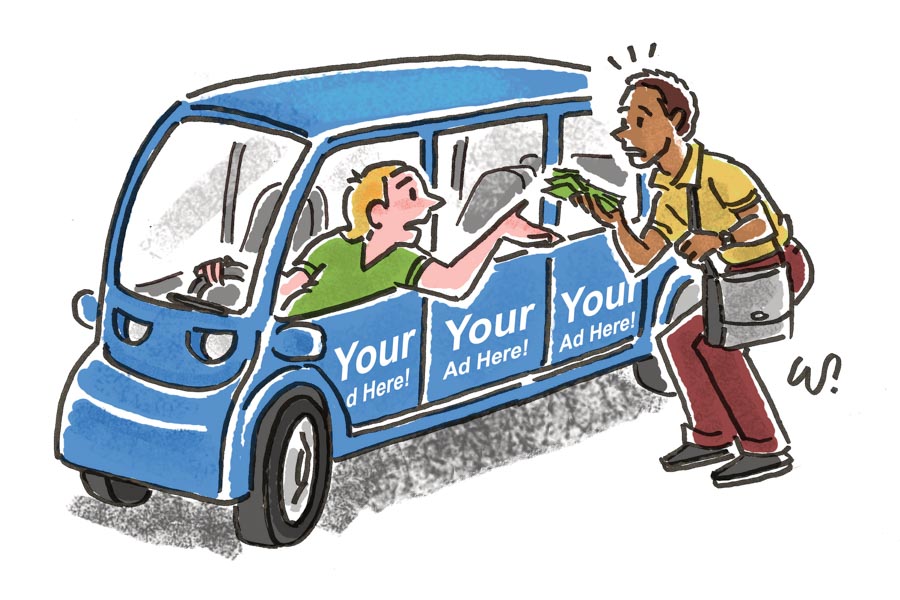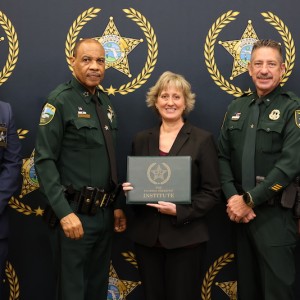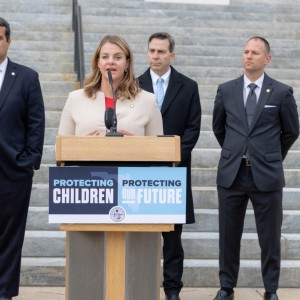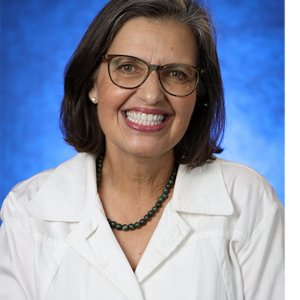The free ride’s over. At least in Downtown Sarasota. Over the course of 16 months, shuttle drivers for the popular iRide transportation service in Sarasota have served close to 70,000 riders who climbed aboard for short trips at no personal cost. During that time, contractor The Gotcha Group managed as well to burn through a $338,000 stipend that was supposed to offset the hard costs of service for two years while the company developed independent revenue streams from tips and advertising.

ILLUSTRATION BY WOODY WOODMAN.
City officials, though, informed the contractor in August it could not provide additional funding for the ride-share experiment. “There’s no reason to move forward with another subsidy with a company who says their business model isn’t working,” says City spokeswoman Jan Thornburg. The city asked iRide to finish out its two-year contract and keep running shuttles here until March, but drivers at some point may start charging riders and the service will eventually cease to exist as it once did.
The episode not only brings to a close a program as popular with riders as its sustainability was evasive. It marks the most recent effort to create public transit on the Gulf Coast with as little burden for users as possible.
Amid reports of city-loving Millennials abandoning personal vehicles, taxi services like Uber and Lyft becoming the tech success story of the decade and transportation officials seeking out new ways to reduce vehicles on the road and calming traffic, why does the Gulf Coast keep missing the bus?
Growing Demand, Shrinking Riderships When the Miami Herald this summer kicked off a series of articles asking Florida thought leaders what issues state candidates should run on this year, public transportation topped the list. “Florida must dedicate serious resources to providing alternative methods of mobility for all its residents,” University of Miami law professor Mary Anne Franks told the newspaper.
Yet for all the talk of people wanting more options for travel, public transportation has remained elusive in Florida for decades.
Some of that just comes in the way Florida settled in the 20th century. “Our population boomed when people were moving to the suburbs,” says Lisa Bacot, executive director of Florida Public Transportation Association. “It’s a different growth pattern than in the Northeast. It’s difficult to serve the suburbs, with people living 20 miles away from where they work.”
It’s a problem for which no one has yet found a popular solution. State voters here passed a referenda calling for high-speed rail, then passed another referenda taking it back once a price tag appeared on the ballot. The Tampa Bay Area Regional Transportation Authority since 2007 worked to create a public transportation network that reached as far south as Bee Ridge Road in Sarasota, but Hillsborough County voters in 2016 nixed a tax to fund the first part of that network. Voters weigh in again on a petition-driven referendum this November, but everyone in adjacent counties still awaits a first step in creating a metropolitan system that still won’t reach Manatee or Sarasota counties for years.
Meanwhile, conversations for a Sarasota Manatee Area Regional Transit [SMART] have yet to shape into hard proposals. County commissioners in the two counties held a joint meeting in July and raised the possibility of merging the county’s bus systems. “Some people who expressed interest in taking that over suggested a consolidation of services,” says David Hutchinson, executive director of the Sarasota-Manatee Metropolitan Planning Organization.
But board members in July were divided on specifics. Sarasota County Commissioner Nancy Detert and Manatee County Commissioner Patricia Trice both expressed skepticism about inviting bids from outside contractors. To date, the counties have not been able to agree to conditions for a request for proposals. Until that hits the streets, no plan will make it before either county commission for a sign-off. “I don’t know if any proposals we consider will encompass Manatee County service or not,” says Kendra Kiederling, Sarasota County Area Transit spokeswoman.
AndwhenSarasotaCounty Commissioners moved to a bid proposal to get plans for private transit in Sarasota, no communications had been received from Manatee about a potential joint venture.
That’s partially because of costs that ridership alone can’t cover. Fixed route ridership on SCAT dropped from 2.7 million riders in 2015 to 2.4 million riders in 2017, according to Sarasota County performance measures. Meanwhile, less than $100,000 of SCAT’s $28.2 million in revenue last year came from user charges; the bulk comes from $20 million in grants to the county with another $8.2 million coming from taxes. In Manatee, about $500,000 of the county’s $9 million in revenues comes from service charges but the system also remains heavily subsidized by taxes and grants. And even as the counties subsidize programs, they face demand for more sheltered bus stops.
Cabot says people need to think of tax subsidies for buses the same way they do roads. While drivers will never roll over ever inch of roadway their taxes helped pave, it creates an infrastructure that helps all, including the poor and disabled, to get around the community. But can anything about the costs change?
The hope in privatizing bus service would be resulting cost savings, especially if counties merged operations. Right now, bus routes overlap at certain areas near the Manatee County line on U.S. 41 and U.S. 301. Notably, a similar merger discussion fell apart two years ago based on the fact that Manatee County Area Transit today provides free ridership to the medically indigent, but expanding that deal to riders in the two-county area could not be done without substantially increasing public subsidization of the service.
Part of charting the future of transit almost surely requires finding some kind of outside funding besides taxes and ridership to keep the buses rolling on time. iRide was supposed to chart that path.
Disappointment on the Line Sarasota leaders in March 2017 greeted a solicitation for iRide downtown with enthusiasm. The city for years heard calls for trolley service, and it prides itself on finding ways to cut pollution. A fleet of electric vehicles supplementing its budget with advertising dollars offered hope.
Thornburg stresses the program in one sense proved remarkably popular. Close to 70,000 riders used the free shuttle in the first 16 months it ran. That’s more than the city projected. But the cost of operating the shuttles proved too much for iRide to handle.
Gotcha CEO Sean Flood told City Commissioners in March that the company anticipated it could fund the salaries of drivers for shuttles entirely on tips from riders. But most people hopping on the free shuttle weren’t voluntarily paying. He says then the service feared a $77,000 shortfall in its initial two-year proposal.
In August, iRide informed the city it could not continue its current business model. Sarasota leaders said they would not continue to subsidize the service and had no plans to renew a contract, and asked that iRide at least continue service through the end of the two-year commitment.
Flood told SRQ in August the rides would continue for now. “The same iRide service residents and visitors have enjoyed since March 2017 will continue to operate as it exists today for the foreseeable future,” he said in a statement to SRQ . “We’ve been working closely with our partners at the City over the last few months to address financial needs and have since reached a mutually beneficial agreement under which Gotcha will operate the service as a private company, without the need for further subsidies from the City. We’re in the process of finalizing the details but iRide will indeed continue to operate as we work out these details, which will ultimately lead to a more robust service for residents and tourists alike.”
Amid that promise of delivering the same great service, though, there was no promise of keeping the shuttle running for consumers for free. City officials were told the service eventually could start charging $1 fares, though for the moment there’s no plan to start charging riders before the end of the contract.
“Gotcha is currently working with the City regarding the operational details of the service, so once those are firmly in place I will be sure to share them,” says Gotcha spokeswoman Anne Morgan.
Since then, iRide reduced its operating hours to run from noon to 7pm on weekdays. The city has formally terminated its relationship to the service, but buses are allowed to operate independently.
Of course, if riders want to pay to get around, there’s still any number of options. In fact, in the wake of the rise of Uber, the City of Sarasota deregulated the cab industry entirely. In 2016, as Uber sought a way to reasonably obtain permission to operate in the city over the objection of professional taxi services, the Commission decided to completely eliminate its permit requirements, and now Uber, Lyft and cab drivers can operate freely in Sarasota.
This spring, the Florida Legislature passed legislation that means ride-sharing services like Uber can operate in any jurisdiction within the state of Florida.
And just as cabs fear the power of Uber and Lyft, public transportation sees more competition for riders. The future, Cabot says, may involve relationships between the public and private sector. Already, some jurisdictions have started negotiations with Uber and subsidizing short rides to get individuals to bus stations and other public transportation outlets, combining the house call service of cab-sharing with the economic advantages of public bussing.









